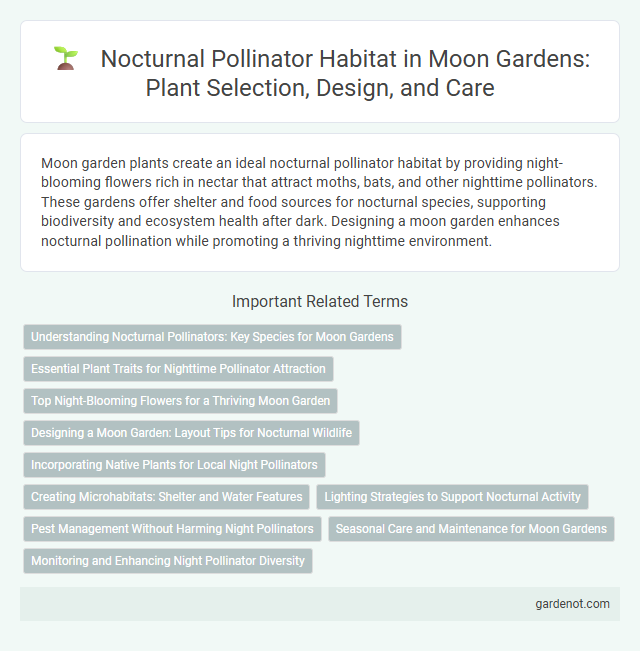Moon garden plants create an ideal nocturnal pollinator habitat by providing night-blooming flowers rich in nectar that attract moths, bats, and other nighttime pollinators. These gardens offer shelter and food sources for nocturnal species, supporting biodiversity and ecosystem health after dark. Designing a moon garden enhances nocturnal pollination while promoting a thriving nighttime environment.
Understanding Nocturnal Pollinators: Key Species for Moon Gardens
Nocturnal pollinators such as moths, bats, and certain beetles are essential for the reproduction of many night-blooming plants in moon gardens. These key species possess adaptations like enhanced night vision and acute olfactory senses, enabling them to locate and pollinate flowers under low-light conditions. Providing a diverse range of night-blooming flora rich in nectar supports the survival of these pollinators and enhances the ecological balance within moon garden habitats.
Essential Plant Traits for Nighttime Pollinator Attraction
Essential plant traits for nighttime pollinator attraction in a moon garden include pale or white flowers that reflect moonlight, strong sweet fragrances to guide nocturnal pollinators, and abundant nectar production to sustain moths, bats, and beetles. These traits enhance visibility and olfactory cues under low-light conditions, facilitating effective pollination by night-active species. Bloom timing aligned with nighttime hours is crucial to synchronize with the activity patterns of nocturnal pollinators.
Top Night-Blooming Flowers for a Thriving Moon Garden
Top night-blooming flowers such as evening primrose, moonflower, night-blooming cereus, and jasmine create an ideal nocturnal pollinator habitat in a moon garden by attracting moths, bats, and night-active bees. These flowers emit strong fragrances and produce nectar throughout the night, supporting the feeding and pollination activities of key nocturnal pollinators. Integrating native night-blooming species enhances biodiversity and ensures a thriving ecosystem tailored for nighttime pollination.
Designing a Moon Garden: Layout Tips for Nocturnal Wildlife
Incorporate native night-blooming flowers such as evening primrose and night-scented stock to attract nocturnal pollinators like moths and bats. Position plants in clusters near water sources and sheltered areas to provide safe foraging and resting spots. Use soft, indirect lighting with motion sensors to minimize disturbance while enhancing visibility for nighttime wildlife activity.
Incorporating Native Plants for Local Night Pollinators
Incorporating native plants such as evening primrose, moonflower, and night-blooming jasmine creates an ideal nocturnal pollinator habitat by providing nectar sources tailored for local night pollinators like moths, bats, and glow-worm beetles. These plants emit strong fragrances and pale or white blossoms that enhance visibility and attract pollinators in low light conditions common in moon gardens. Supporting native night-pollinating species promotes biodiversity and helps maintain the ecological balance critical for sustainable gardening.
Creating Microhabitats: Shelter and Water Features
Creating microhabitats within a moon garden enhances nocturnal pollinator activity by providing essential shelter and water sources. Incorporating features such as small rock piles, hollow logs, and shallow water dishes supports moths, bats, and night-flying beetles by meeting their resting and hydration needs. These microhabitats increase biodiversity and improve pollination efficiency during nighttime hours.
Lighting Strategies to Support Nocturnal Activity
Effective lighting strategies in moon gardens prioritize low-intensity, warm-spectrum bulbs to minimize disruption of nocturnal pollinators such as moths and bats. Positioning lights away from primary pollinator habitats and using shielded fixtures reduces light pollution and preserves natural foraging behaviors. Timers or motion sensors further limit light exposure, creating optimal conditions for nocturnal activity and supporting biodiversity.
Pest Management Without Harming Night Pollinators
Moon gardens provide an ideal habitat for nocturnal pollinators such as moths and bats, which play a crucial role in maintaining biodiversity. Effective pest management in these gardens involves using organic and targeted methods like neem oil or bacterial pesticides that minimize harm to beneficial night pollinators. Avoiding broad-spectrum insecticides ensures that essential pollinator populations remain healthy and active during nighttime hours.
Seasonal Care and Maintenance for Moon Gardens
Nocturnal pollinator habitats in moon gardens require seasonal care to ensure thriving ecosystems for moths, bats, and night-flying bees. Regularly removing fallen leaves and pruning late-blooming night flowers promotes healthy growth and maximizes nectar availability during peak pollination months. Mulching with organic matter conserves soil moisture and supports beneficial soil microbes critical for nocturnal pollinators' foraging activities throughout spring to fall.
Monitoring and Enhancing Night Pollinator Diversity
Nocturnal pollinator habitats in moon gardens support vital species such as moths, bats, and beetles that contribute to nighttime pollination. Monitoring involves using light traps and acoustic sensors to track species diversity and activity patterns accurately. Enhancing these habitats includes planting night-blooming flowers like evening primrose and jasmine, creating water sources, and minimizing artificial light pollution to promote a thriving nocturnal pollinator ecosystem.
Nocturnal pollinator habitat Infographic

 gardenot.com
gardenot.com